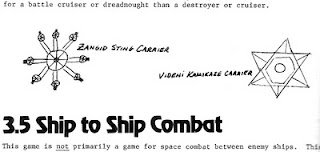
 So as I said last week, I got tired of Advanced Dungeons & Dragons and started looking for another game to play. But I think I started looking even before I got very tired of D&D.
So as I said last week, I got tired of Advanced Dungeons & Dragons and started looking for another game to play. But I think I started looking even before I got very tired of D&D.Part of it, I think, was just wanting to try being the Game Master myself. And part of it was wanting to try out some of the other possibilities that might exist beyond the TSR universe. I had heard of other games put out by TSR, like Boot Hill (role-playing in the Old West) and Gamma World (role-playing in a post-apocalyptic wasteland), but for some reason they didn't appeal to me. TSR seemed like like a pretty stodgy company (although that may have just been due to Gygax's pedantic writing style), and I wanted something fresher. Besides, the people in my gaming group had already played those games, and I wanted to introduce to them to something they'd never seen before.
The first non-D&D game I ended up picking up was Starships and Spacemen, designed by Capt. Leonard H. Kanterman of the U.S. Army Medical Corps and published in 1978 by Fantasy Games Unlimited. FGU was the company that put out Chivalry and Sorcery, as well as a Flash Gordon game that it described as "Schematic role-play." I still have no idea what that means. They also put out the legendary Bunnies and Burrows.
You may have noticed a running theme here. FGU liked to publish games with names that consisted of Noun & Alliterative-Other-Noun, a trend they would continue with Villains and Vigilantes. And eventually I learned a lesson from FGU's products:
Role-Playing Rule #5: If they can't be bothered to come up with an interesting, original name, there probably won't be much of anything original or interesting in the rules either.
Starships and Spacemen was a perfect example. It was basically Star Trek crossed with Dungeons & Dragons (Kanterman explicitly says this in a section on the inspiration for the game). The basic game mechanics were the same: random stat rolls on three 6-sided dice, non-human races with bonuses for certain stats, military branches substituting for character class, level-based advancement, one-minute combat rounds with attack rolls on 20-sided dice.
I was sorely disappointed with the game and never actually tried to run it. It just tried to cram too much stuff into too few pages, and a lot of it was lame. There were rules for setting up a space sector full of traps like dust clouds and space mirrors. And there was an entire page of sci-fi diseases PC's could catch, like Psionic Fever, Space Malaria and Lover's Lunacy. There were tables for wildlife encounters with alien creatures like Psionic Porcupines, Power Pumas and Space Skunks.
And then there were the spaceship rules, accompanied by highly technical ship drawings like this:
The back of the book contained several scenarios that were basically bare outline mission briefings setting up situations that the Game Master (in S&S parlance, the "Starmaster" or SM) would have to flesh out. For instance, one sample mission involves the crew of the Bunker Hill (named Janis T. Jerk, Christopher Carp, Montgomery Ward, Mister Schlock, Cerulean Blue and Red-Nek) delivering a dangerous prisoner named "Bloody Dick" Caveat to a penal colony in a sector of space where several other ships have recently disappeared.
That's it. No stats, no explanation. Just a bunch of stupid names and a warning that the area is dangerous and the prisoner is dangerous.
To say I was disappointed with the game is an understatement. In point of fact, the thought of running the game embarrassed me so much that I don't think I ever even showed the book to any of my friends. Later, I would find games that I did want to run and embarrass myself even more. But I'll tell those stories another time.




No comments:
Post a Comment